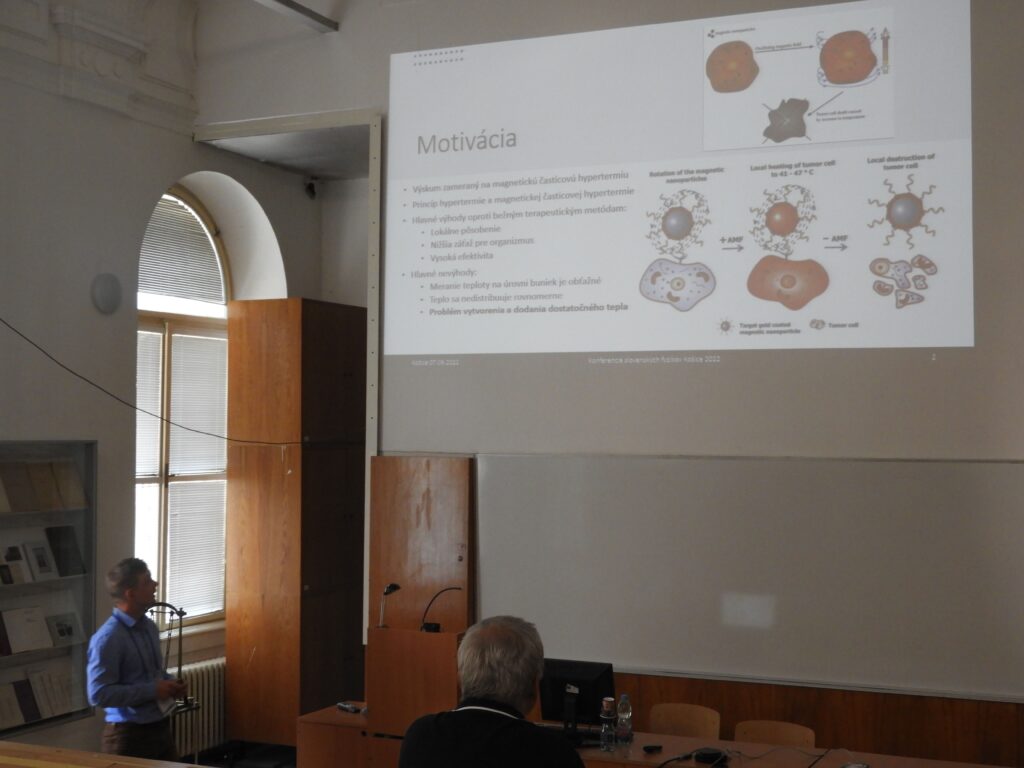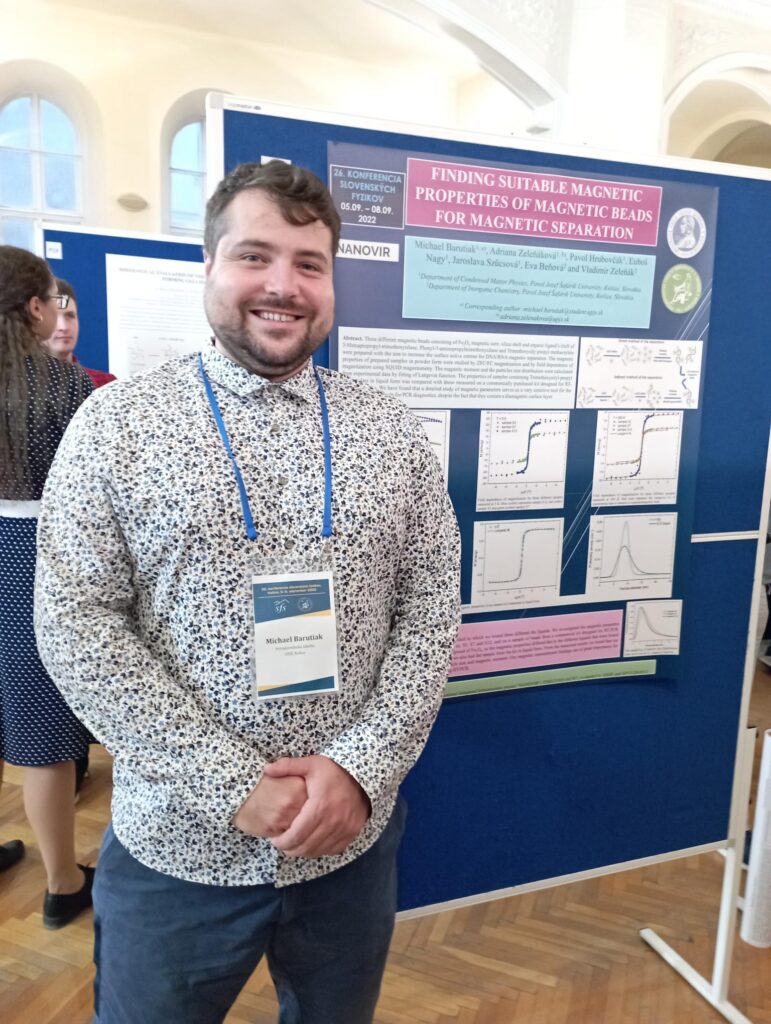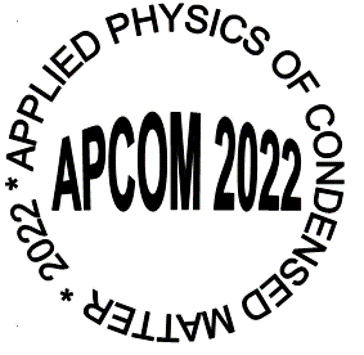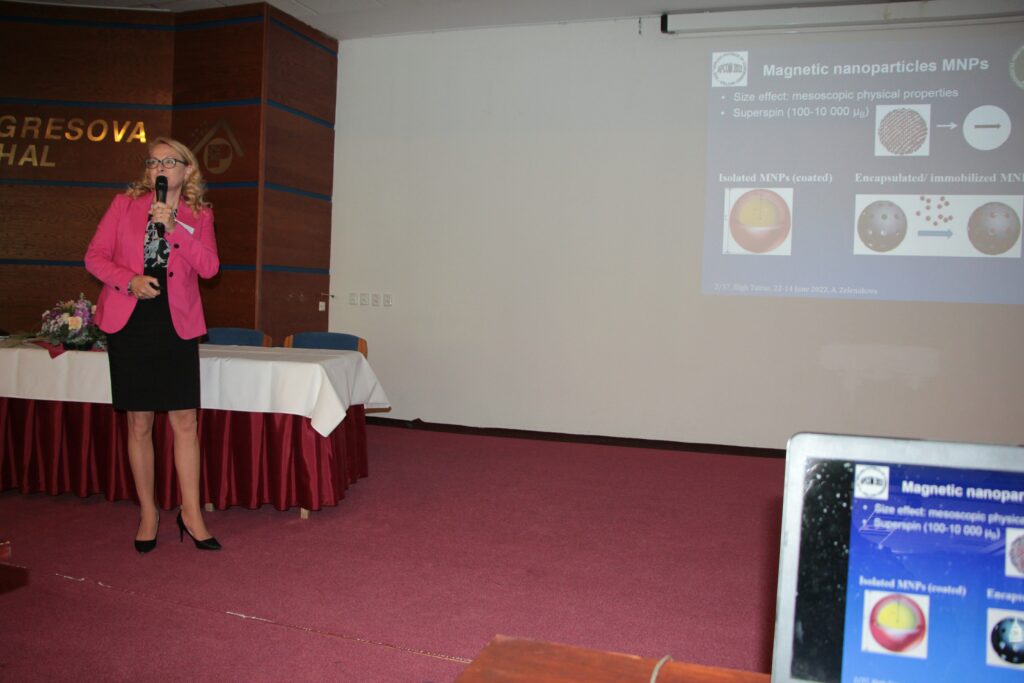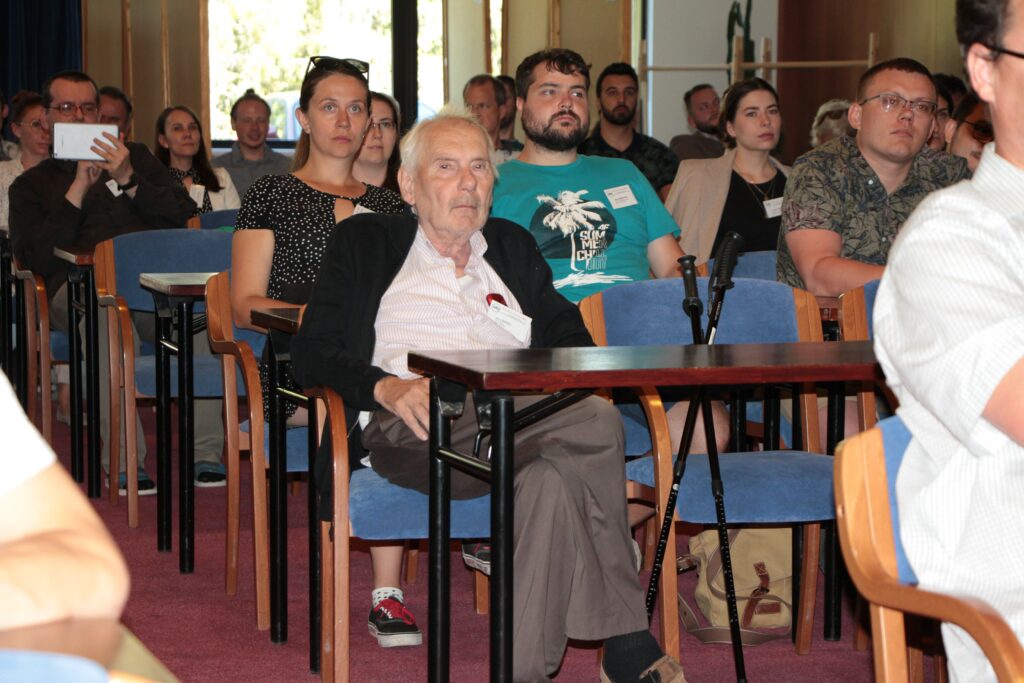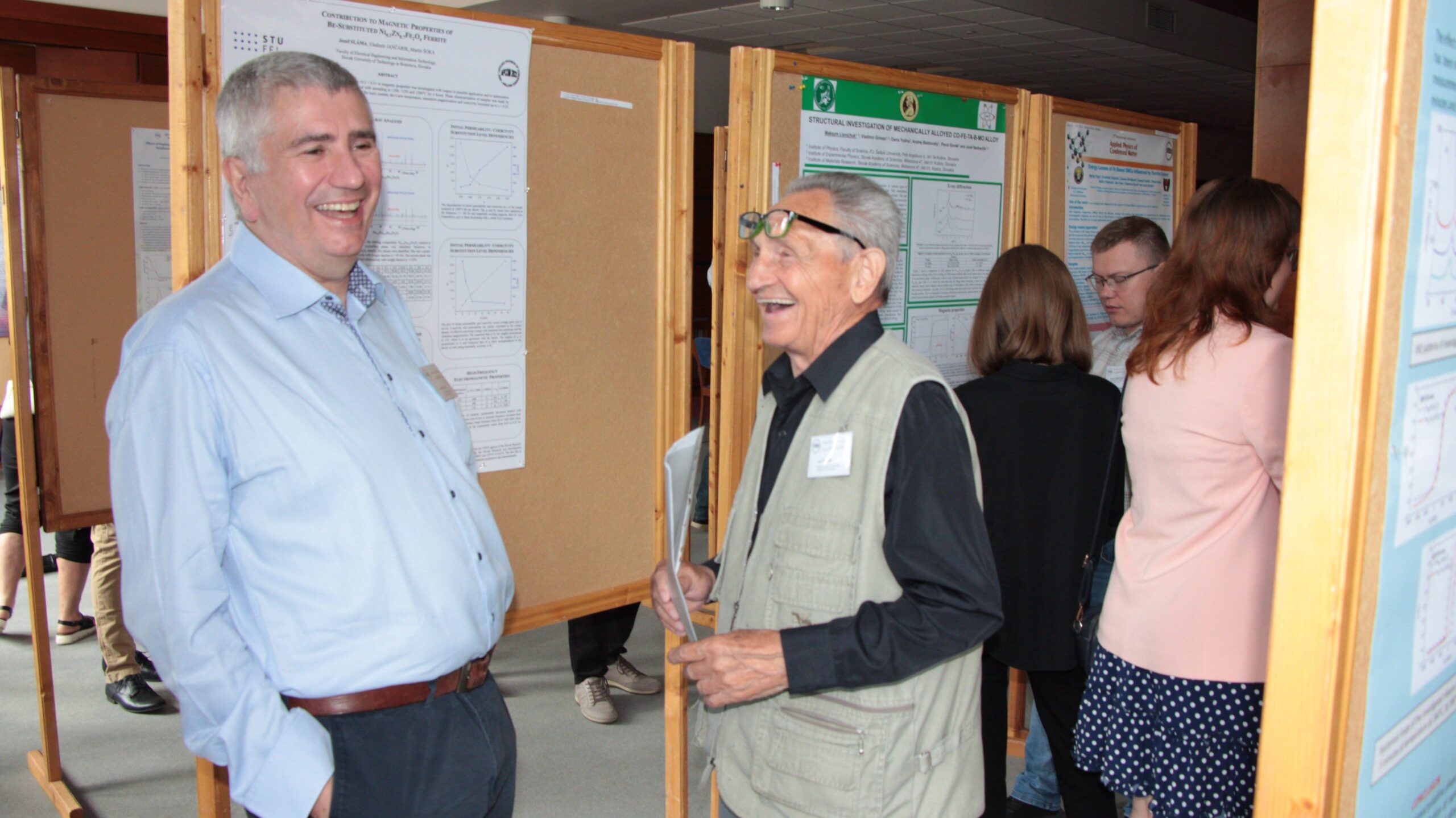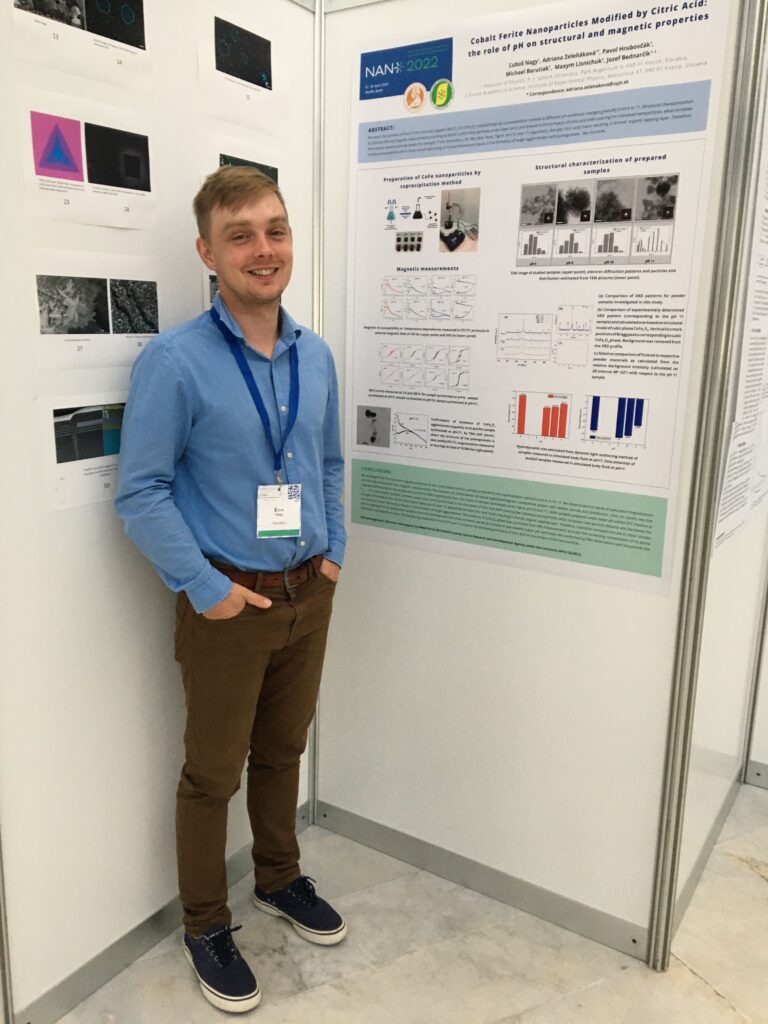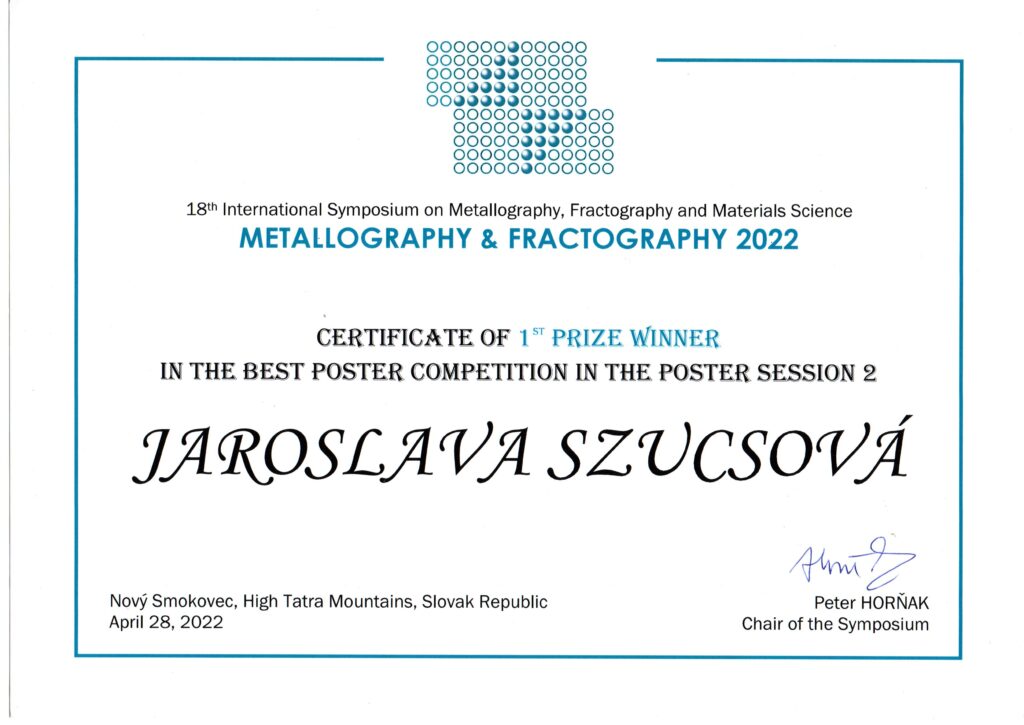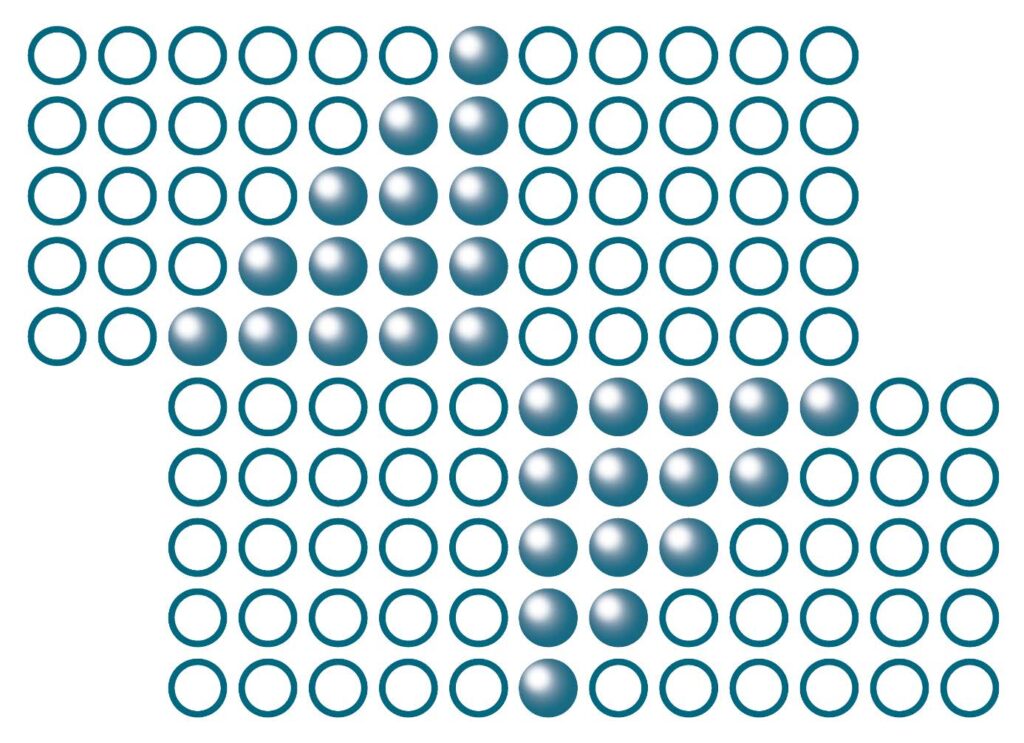
ICPAM 2022
14th International Conference on Physics of Advanced Materials
Plenary speaker: Adriana Zeleňáková
Magnetic Nanoparticles for Solving Diagnostics -Therapeutic problems with COVID-19
September 08-15, 2022
Dubrovnik, Croatia
26. Konferencia slovenských fyzikov 2022
Study of magnetic nanoparticles CoFe2O4 as heat sources in magnetic particle hyperthermia
Ľ. Nagy, A. Zeleňáková, P. Hrubovčák, N. Mielnik, J. Szucsová
September 05-08, 2022
Pavol Jozef Šafárik University, Institute of Physics, Košice, Slovakia
APCOM 2022
Introductory Lecture:
Magnetic Nanoparticles for Solving Diagnostics -Therapeutic Problems with COVID-19
Adriana Zeleňáková, Vladimír Zeleňák, Pavol Hrubovčák, Jaroslava Szűcsová,
Eva Beňová, Ľuboš Nagy, Michael Barutiak and Štefan Vilček
June 22-24, 2022
Hotel Patria****, Štrbské Pleso, High Tatras, Slovakia
In this study, we describe the preparation, design, structural, magnetic and functional properties of magnetic
nanoparticle systems for biomedical applications as drug carriers, and magnetic RNA separation. Magnetic separation is one of the most efficient and fastest methods currently used in nucleic acid isolation and is also applied the COVID-19 pandemic. An essential part of this methodology are core-shell magnetic nanoparticles, which are necessary in the first stages of the diagnostic chain, during the separation of biological material. The magnetic nanoparticles will be surface and structurally modified to achieve better separation efficiency. The quality of the prepared nanoparticles will be verified by isolation of viral RNA for detection of RNA viruses by RT-qPCR method. In addition, the lecture includes a view of the COVID-19 pandemic from a therapeutic perspective, when core-shell magnetic nanoparticles will be used as a carrier of a model antiviral drug and the influence of such systems on cell viability and metabolic activity in vitro will be monitored and analyzed in correlation with magnetic properties.
Comparison of Magnetic Properties of Magnetic Beads for
Magnetic Separation
Michael Barutiak, Adriana Zeleňáková, Pavol Hrubovčák, Ľuboš Nagy,
Jaroslava Szűcsová, Eva Beňová and Vladimír Zeleňák
June 22-24, 2022
Hotel Patria****, Štrbské Pleso, High Tatras, Slovakia
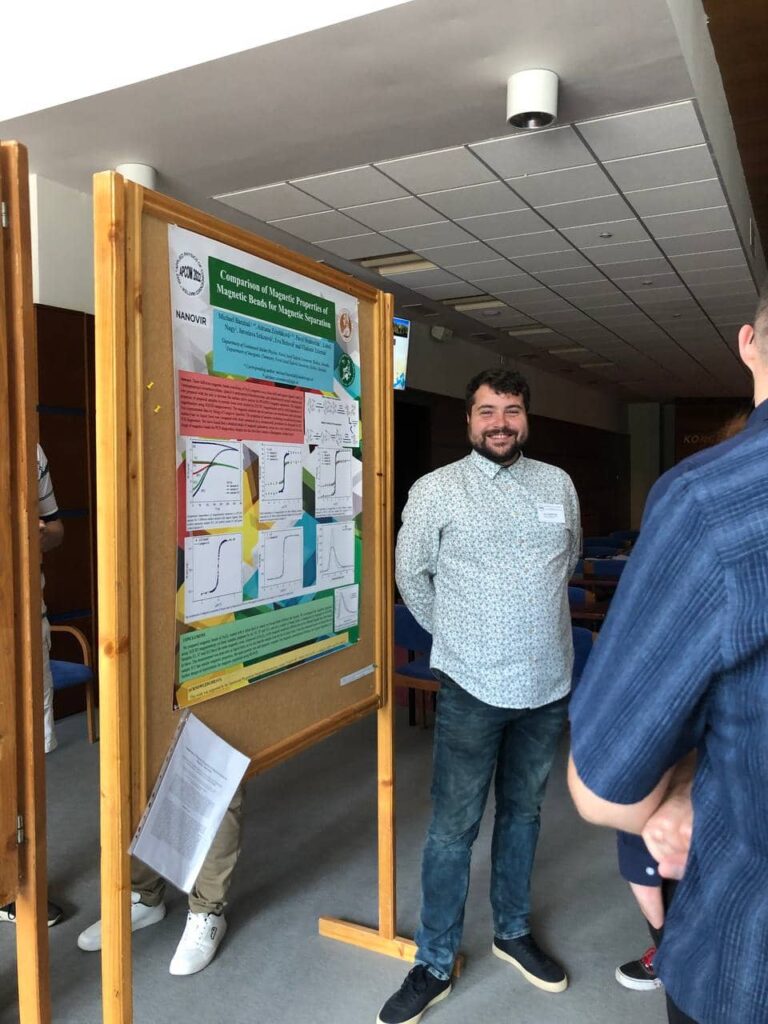
Three different magnetic beads consisting of Fe3O4 magnetic core, silica shell and organic ligand’s shell of 3-Mercaptopropyl-trimethoxysilane, Phenyl-3-aminopropyltrimethoxysilane and Trimethoxysilypropyl
methacrylate were prepared with the aim to increase the surface active centres for DNA/RNA magnetic separation. The magnetic properties of prepared samples in powder form were studied by ZFC/FC magnetization and by field dependence of magnetization using SQUID magnetometry. The magnetic moment and the particles size distribution were calculated from experimental data by fitting of Langevin function. The properties of samples containing rimethoxysilyl-propyl methacrylate in liquid form was compared with those measured on a commercially purchased kit designed for RT-PCR diagnostics. We have found that a detailed study of magnetic parameters serves as a very sensitive tool for the design of magnetic beads for PCR diagnostics, despite the fact that they contain a diamagnetic surface layer.
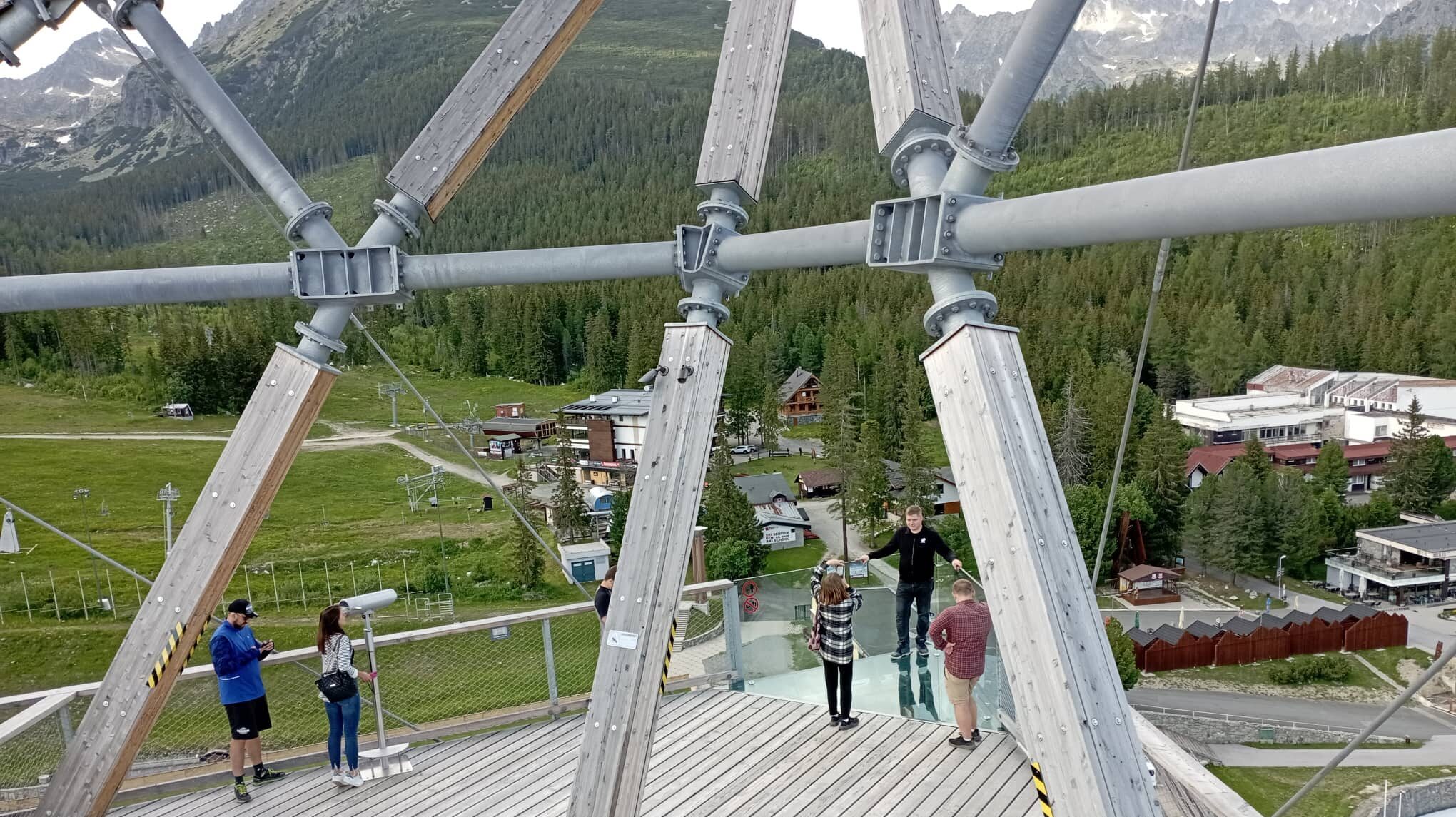


NANO 2022
Magnetic The effect of functionalized coating on magnetite nanoparticles
A. Zeleňáková, V. Zeleňák, E. Beňová, P. Hrubovčák, Ľ. Nagy, J. Szűcsová, M. Barutiak, M. Klementová, J. Kupčík
June 6-10, 2022
The Barceló Sevilla Renacimiento*****, Sevilla, Spain

Last two years have shown us our limits in the fight with global pandemic. The spread of COVID19 disease revealed our vulnerability and onefficiency when dealing with a kind of serious virus in general. Despite of a large effort of scientific community, many crucial questions regarding corona virus disease are still remaining inaddressed. The most important concern a fast and plausible diagnostics and effective treatment. In response to these challenges, we have developed nanocomposite systems based on Fe3O4 magnetic nanoparticles (NPs) for COVID19 diagnostics and therapeutic applications. Series of nanoparticles systems with magnetic core and amorphous silica (SiO2) shell have been prepared and their surface has been modofied by specific organic ligands. Owning to the ligands, the prepared NPs are capable of bonding either virus RNA or anti.virus drug. By the action of applied magnetic field, the NPs may be concentraited in a certain point (diagnostics) or delivered into the affected tissue (treatment). Feasible magnetic performance of the prepared nanoparticles system is therefore crucial for their application. We have conducted series of magnetic measurements in order to distinguish between magnetic behavior of the pure nanoparticle system and systems with various coatings. We demonstrate the application of the fundamental models that have been modified in order to fit the experimental zero-field cooling magnetization data. We discuss the influence of the nanoparticle shell parameters on the overall magnetic performance of the systems. With the aid of magnetic data modeling along with the strong experimental support provided by other methods we can conclude on nanoparticle strutural and magnetic characteristics and the presence/absence of interparticle interactions. Accurate determination of nanoparticle system properties is essential for its further tuning towards the desired application.
Nanoporous silica as a smart material for drug delivery
V. Zeleňák, A. Zeleňáková, E. Beňová
June 6-10, 2022
The Barceló Sevilla Renacimiento*****, Sevilla, Spain
The main goal of our work was the preparation, characterization and testing of new smart nanoporous matrices as materials for targeted drug transport and delivery. Porous silica of different symmetry and pore size has been investigated for drug loading and release. Various types of drugs have been used in the studies, for example the non-steroidal anti-inflammatory drugs naproxen, indomethacin or the cytostatics like 5-fluorouracil, doxorubicin, pemetrexed. Within the study, different systems were prepared that allow the release of the drug due to the following stimuli: i.) light, ii.) pH, iii.) redox potential, iv.) hydrophobicity of the surface, v.) temperature. For example, a system based on silica and a photoreactive derivative of p-hydroxycinnamic acid showed a reversible ability to open and close pores and thus control the drug release. The results of the release of naproxen clearly confirmed the reversible photodimerization reaction on the silica surface and the possibility of using of such prepared
material to control the release of drugs using a photo stimulus. A change in pH was used as another stimulus for controlled drug release. In the preparation of drug-releasing materials due to a change in pH, „nanovalves“ consisting of an amine ligand and a cyclodextrin were anchored on the surface of the silica. Release of the drug into the simulated body fluid (pH = 7.4) showed no release, the silica pores were tightly closed. In contrast, at pH = 5, a gradual release of the drug was observed over time. A redox-responsive drug delivery system, based on a porous SBA-15 carrier containing a dithiol bond, the pores of which were closed with ZnS nanoparticles, was also prepared and investigated. Doxorubicin (DOX), a chemotherapeutic used to treat various types of cancer, was used as a model drug in the study. The dithiol bond was cleaved by redox-active molecules, such as dithiothreitol or glutathione, whose concentration in cancer cells is 4-fold higher compared to healthy cells. Three times more doxorubicin was released into the dithiothreitol solution from the system than into pure saline. The concept of the functionality of the systems described above was also investigated in real biological samples, during in vivo experiments, using experimental animals, Wistar rats. The study confirmed that the developed concept of drug carriers is functional also in living systems. In addition in vitro studies were performed on human glioma U87 MG cells and SKBR3 cells. The biocompatibility of the pH sensitive silica was tested in a CAM quail model in a microcirculatory system. Biological studies showed remarkable results when silica alone did not show cytotoxicity, but the cytotoxicity of drugs when encapsulated in silica was higher than that of cytostatic drugs when administered alone.
Magnetic properties modeling of functionalized magnetite nanoparticles
P. Hrubovčák, A. Zeleňáková, M. Klementová, J. Kupčík, E. Beňová, J. Szűcsová, V. Zeleňák
June 6-10, 2022
The Barceló Sevilla Renacimiento*****, Sevilla, Spain
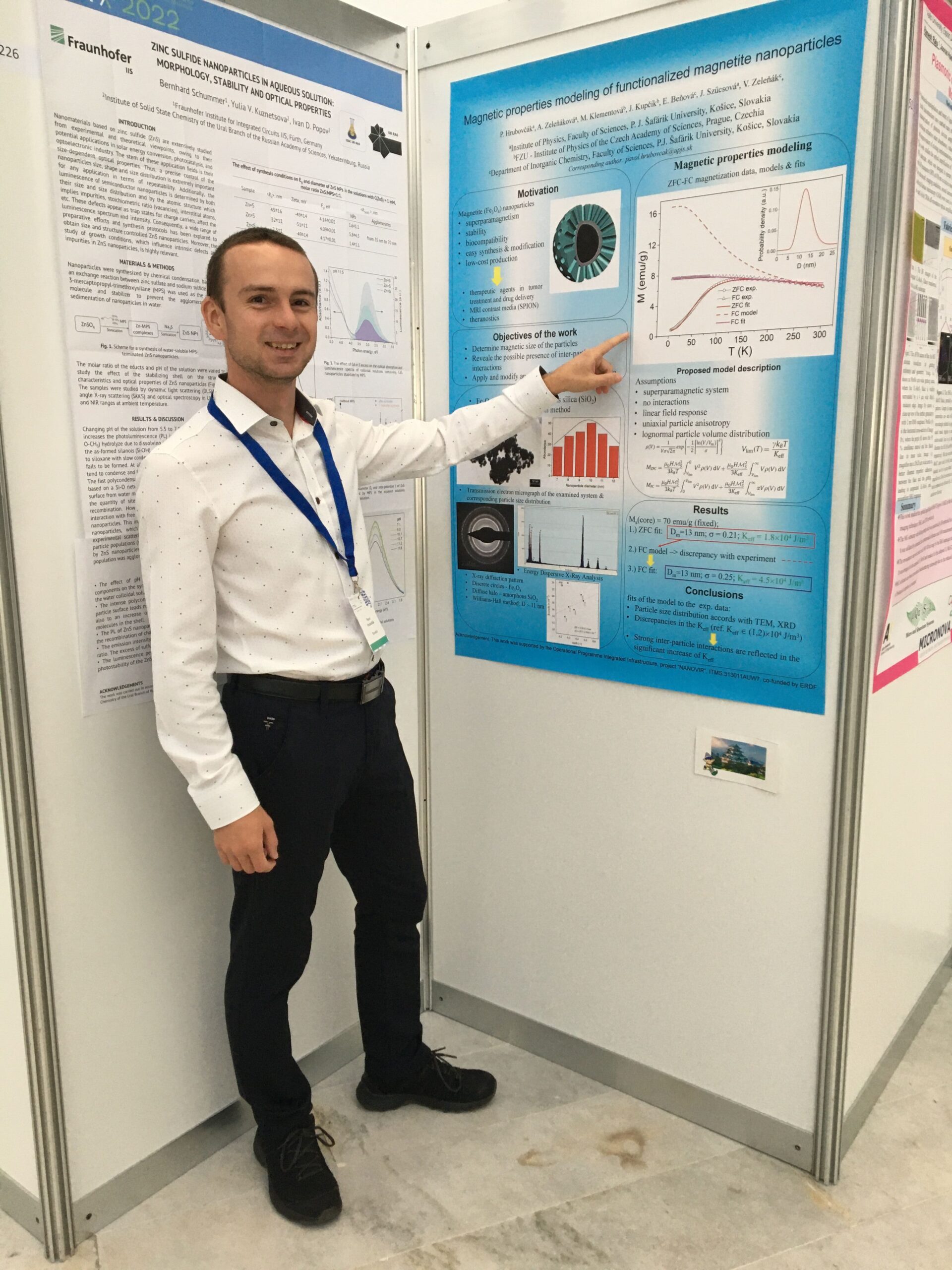

Magnetite (Fe3O4) nanoparticles (NPs) belong to the group of the nanoscale systems with the largest area of application. Their popularity stems from the unique combination of feasible properties that meet only a few materials. Superparamagnetism, stability, biocompatibility, easy synthesis and surface modification along with low-cost production imply the utilization of magnetite NPs in particular in biomedicine. Despite of an extensive work that has been dedicated to a number of Fe3O4 nanoparticle systems characterization, the prediction of their magnetic behavior is still elusive and often in discordance with experimental data. It is known that coating of Fe3O4 cores by functionalized shell significantly affects magnetic performance of the system. Particle magnetic moment decrease, superparamagnetic blocking temperature shift or mutual interparticle interactions reduction are the most remarkable changes usually induced by particle coating. In order to contribute to the elucidation of the magnetic phenomena that are typical of functionalized magnetite NPs, we have prepared and examined complex nanoparticle systems consisting of three features. Magnetic Fe3O4 core that is covered by amorphous silica (SiO2) shell and modified by bonding of a specific organic ligand to its surface. The studied nanoparticles are representatives of theranostic multifunctional systems and they have been designed for rapid diagnostics and effective treatment of virus diseases. The influence of capping layer on the magnetic performance of the prepared systems has been investigated by means of zero-field cooling (ZFC) and field cooling (FC) magnetization vs temperature measurements. Appropriate models have been selected, modified and employed in order to fit the ZFC-FC experimental data. The best model fit provided median magnetic core diameter dm ~ 10 nm by assuming log-normal particle size distribution. The result is in very good agreement with the values obtained by other experimental methods (electron microscopy, X-ray diffraction).


On the other hand, the location of ZFC curve maximum (often regarded as nanoparticle blocking temperature) TB ~ 150 K has been found rather different when compared with the reported systems of similar size and composition. The apparent discrepancy can be attributed to the influence of the diamagnetic shell and this feature is also discussed in our work.
Cobalt Ferite Nanoparticles Modified by Citric Acid: the role of pH on structural and magnetic properties
Ľuboš Nagy, Adriana Zeleňáková, Pavol Hrubovčák, Michael Barutiak, Maxym Lisnichuk, Jozef Bednarčík
June 6-10, 2022
The Barceló Sevilla Renacimiento*****, Sevilla, Spain
We report the synthesis of fine (~5 nm) citric acid capped CoFe2O4 (CA-CoFe2O4) nanoparticles by co-precipitation method at different pH conditions changes gradually from 6 to 11. Structural characterization by TEM and XRD and magnetic measurements providing by SQUID confirm that synthesis under lower pH (6 and 9) leads to the formation of citric acid shell covering the individual nanoparticles, what increases inter-particle distance and decreases the strength of the interactions. On the other hand, higher pH (10 and 11) apparently disrupts citric acid chains resulting in thinner organic capping layer. Therefore, individual nanoparticles are in closer contact and acting of mutual interactions results in the formation of larger agglomerates with pomegranate – like structure.



METALLOGRAPHY & FRACTOGRAPHY 2022
Influence of ligands on physicochemical characteristics
of magnetic nanoparticles
Szucsova Jaroslava, Zelenakova Adriana, Nagy Lubos, Barutiak Michael,
Benova Eva, Zelenak Vladimir and Zavisova Vlasta
April 27–29, 2022
Atrium Hotel***, Novy Smokovec, High Tatras, Slovakia




